Retired Certified Safety Supervisor, Gary Whistler, discusses the importance of knowing your rig dimensions and the critical differences between driving unloaded and loaded. Get your measuring tape out now.

We are very fortunate to have within our community ranks a retired professional truck driver with over two-million accident-free miles behind him. As a passionate truck camper owner, Gary stepped up at the 2013 Gettysburg Truck Camper Rally and presented a crash course – if you’ll excuse the expression – in truck camper driving safety. We were so impressed that we followed up with him after the event to develop, “Truck Camper Driving Safety 101: The Basics”.
Reader response to Gary’s first Truck Camper Magazine article was off the charts. Even industry leaders chimed in to state how much they appreciated Gary’s experience and perspective. Lance Campers went so far as to share Gary’s article with their entire team and dealer network for training purposes. Now that’s how we take a step towards making our truck camper industry and community safer. Bravo Lance!
For “Truck Camper Driving Safety 102”, Gary shares even more advice taking us through the what, where, and why of measuring our rigs, and offers the best practices for driving unloaded and loaded trucks. Finally he gives us a few more safety tips and tricks. Thank you Gary.
Truck Camper Diving Safety 102
by Gary Whistler
Let’s Discuss Your Dimensions
There are a lot of variables that make up a truck camper’s overall length, width, and height. First, there are many different truck camper manufacturers building many different models and configurations of truck campers. Second, there are several different truck manufacturers building many different models and configurations of trucks.
Add to the above variables any changes made to tires, suspension, towing systems, and roof mounted options and you quickly discover how every truck camper is dimensionally different than the next.
With the overall dimensions of every truck camper rig being unique, it’s critical to measure your truck camper for length, width, and height. I prefer to do this the old fashioned way; with a tape measure.
To accurately measure a truck camper, I recommend a twenty-five foot (or longer) tape measure. I also recommend having your spotter with you to hold the tape end in place, or read the tape. Speaking from experience, it can be a challenge to measure a camper by yourself.
Height Priority
The most important dimension to know about your truck camper rig is height. My wife and I found out about this in a story that’s funny now, but wasn’t so funny when it happened.
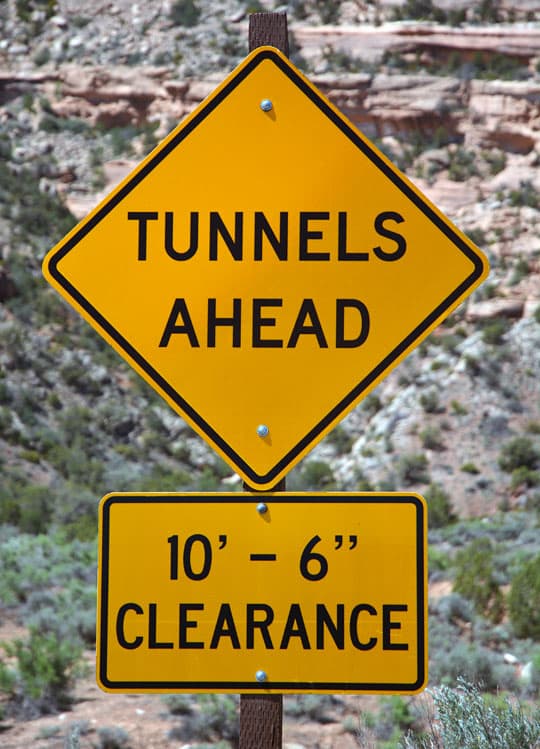
Above: Know your rig height and pay attention to clearance signs along your route
Not too long ago, our GPS took us right to a low clearance tunnel on a country road. Fortunately, we saw the tunnel height sign in time and avoided a costly and potentially dangerous accident. We had tape measured our rig and knew our height. That overpass would have sheared off our air conditioner, or worse. We were lucky that time, but I still had a few choice words for our GPS.
 |
 |
 |
 |
 |
 |
Above: Northern Lite with kayaks was 11’10”, Lance 1055 with air conditioner was 11’10”, and Northstar pop-up with top down was 8’9″- heights were measured at the 2014 Mid-Atlantic Truck Camper Rally. Click to enlarge photos.
The moral of the story is two fold. First, every truck camper owner should know the exact height of their truck camper rig including roof racks, cargo containers, kayaks, canoes, and any other stuff you mount on the roof. That means actually properly measuring the height of your rig with a measuring tape. The second moral is to never 100% trust your GPS. They’re a wonderful tool, but they won’t pay for a shattered air conditioner.
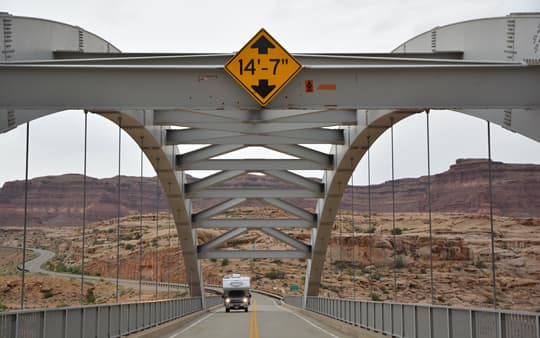
Above: A bridge in Utah on Route 95
Okay, there’s one more moral to the story; pay close attention to overpass height signs. Unless it’s otherwise posted, federal and state highways are all designed to accommodate a minimum of 13 feet 6 inches. What will catch you are railroad bridges and other side street overpasses that are usually located away from major highways. Some railroad bridges on the East Coast can be as low as 10 feet. If they’ve paved the road, it can even be less than what’s marked.
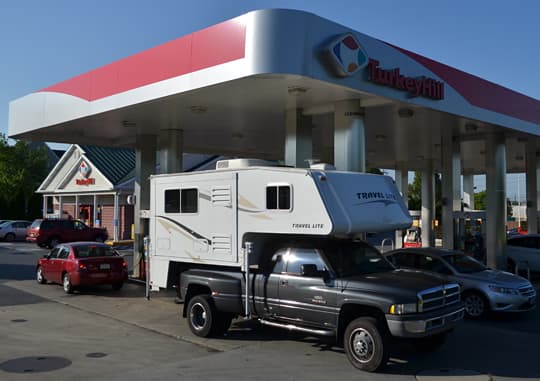
Above: Most fuel stations are within height requirements of a truck camper, but it’s still important to pay attention to clearance signs
Other height considerations include drive-throughs, balconies, roof eaves, electrical wires, tree limbs, and the occasional low service-station canopy. Know your rig height, and pay attention.
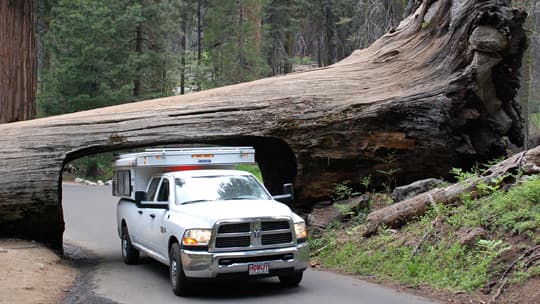
Above: Height may even be an issue with pop-up campers. This tree tunnel in Sequoia National Park is 8’0″.
Length In Numbers
 |
 |
 |
 |
 |
 |
Above: Northern Lite 10-2 RR was 24’10”, Lance 1055 was 23’4″, and Northstar pop-up was 22’8″ lengths were measured at the 2014 Mid-Atlantic Truck Camper Rally.
While nearly everyone knows the importance of measuring the height of their rig, too many overlook the need to measure the length as well. If you ever plan on taking a ferry with your truck camper rig, they almost always charge by the foot – and yes, your tow hitch will count. If you have pre-measured your rig, there will be no expensive surprises before boarding.
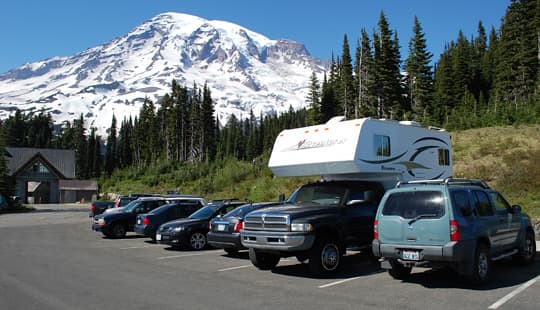
Above: The spaces are few at Mt. Rainier, but with a truck camper, you can fit
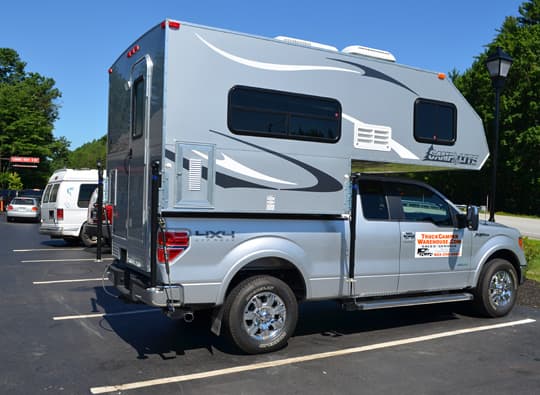
Above: With a Ford F-150 and CampLite, you’d be even shorter than a parking spot
It’s also good to know if your rig will fit into an average parking space. Most parking spaces in the United States are between 18 and 20 feet deep. The DOT standard is 19 feet. If you have an eleven foot hard side on a four door long bed truck, chances are you will pushing into the low 20 foot range. This might be important to know before you pull into that parking space in down town Main Street.
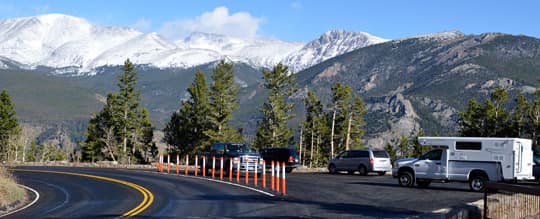
Above: Parking in a scenic pull-off in Rocky Mountain National Park, Colorado
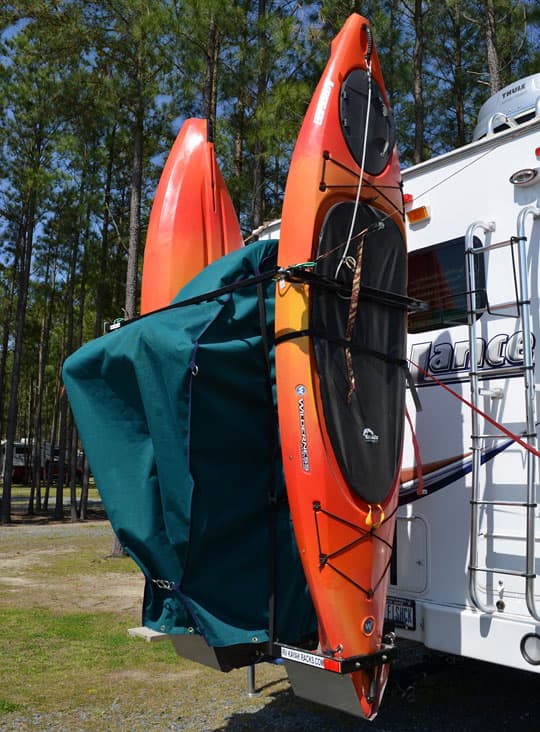
Above: If you are towing or have a hitch with bikes or kayaks, make sure you measure with the full length of your rig.
 |
 |
 |
Above: With Carol Ann and Bob Lawrence’s Lance 1191, they have kayaks and bikes on the back. We ran out of tape at 25’0″, so we had to put our finger down at the sticker and add the two lengths together. The first measurement was 24’5″ and the second was 6’0″, for a total length of 30’5″.
Wide Do You Ask?
 |
 |
 |
 |
 |
 |
Above: Including the jacks, the Northern Lite 10-2 RR was 7’10.5″, the Lance 1191 (center top) and Lance 1055 (center bottom) both measured in at 8’3″, and Northstar pop-up was 7’1.5″ widths were measured at the 2014 Mid-Atlantic Truck Camper Rally.
Truck camper rig width is probably the least important dimension to know, but it’s still important. Pay particular attention to the width added by your side mounted awnings. When passing through narrow spaces – like a toll booth – you will not be able to see your awnings in your mirrors. Knowing your awning on the passenger’s side comes out five inches will let you know to give that side a little more space.
Knowing your height, length, and width can save you a lot of trouble. Having this critical information will also be handy for the next, “How tall is your rig” rally conversation. Publicly admitting you don’t know could send half a dozen guys running for their tape measures and climbing on your rig. Don’t let this happen to you.
Even if you know your rig dimensions, always use the GOAL method (Get Out And Look) when dealing with campgrounds and other potentially tight situations. Many camper corners, awnings, ladders, and air conditioners have been destroyed because we just get in a hurry.
The Driving Experience: Unloaded Truck
 |
 |
 |
Above: At the 2014 Mid-Atlantic Truck Camper Rally, Gary wanted to show the height of the truck’s bed. Billy Warner unloaded his camper at the rally, so we measured his 2006 Ford F-350, four wheel drive, dually at the rally. Gary reminded us that suspension products could potentially raise the height of your truck by a couple inches.
Many of us in the community and industry take the experience of driving a pickup truck for granted. We forget that many newbies to truck campers are also newbies to trucks. They have driven cars, minivans, or SUVs their entire lives and, until now, had never considered owning a full-size pickup truck. For some, this is an exciting proposition. For others, it can be intimidating.
Driving an unloaded and empty pickup truck is both similar and very different than driving a regular sized automobile. An unloaded truck will have a similar vehicle reaction time, brake lag, and stopping distance compared to a car. This is accomplished with larger tires and brakes designed to handle the increased size of the truck. The ride and overall driving quality of late model trucks is also very similar to an automobile. New trucks don’t drive like old trucks, they’re quieter, smoother, and more refined than ever.
There are some important differences between driving an empty truck and a car. You will immediately notice that you sit higher giving you improved visibility to see over traffic. That height can also mean blind spots right in front of your vehicle where shorter automobiles can be harder to see. Just keep in mind that your truck hood may be hiding the better part of a Smart Car, Mini Cooper, or Fiat 500. Despite what you learned from playing video games, there are no points for driving over small foreign cars.
If you opted to drive a dual rear wheel truck, it can take additional time to get used to the increased width of your truck. As always, use your mirrors, and take your time getting used to driving a wider vehicle. The dually fenders are almost never wider than your truck camper rig. Time behind the wheel of your truck will result in increased confidence. Soon you’ll be able to relax and enjoy the ride. And then you’ll know the secret; driving trucks is fun!
Driving Experience: Loaded Truck
The experience of driving your truck will change dramatically with the weight of a wet and loaded truck camper. The weight of the camper will engage the trucks suspension system often resulting in an even smoother and more comfortable ride than when the truck was empty. This is especially true for heavy duty trucks with suspension systems designed for several thousand pounds of payload.
The width of a loaded truck camper should always necessitate fully extending your tow mirrors or, if you don’t have them, installing extendable tow mirrors should be a priority. Don’t drive a truck camper rig if your side mirrors don’t allow you to properly see. On the road, side mirror visibility is critical to your safety.
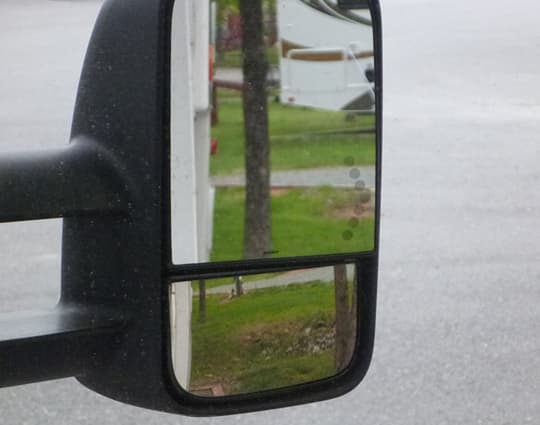
Above: Passenger’s side mirror; when adjusted properly you can see the camper’s jacks in the left side of the mirrors.
I touched on this subject for my first article, “Truck Camper Driving Safety 101: The Basics”, but it’s worth repeating here. While sitting in the driver’s seat, find your natural seating position and adjust your mirrors. You should just be able to see the front corners of your camper in your right and left side mirrors.
If adjusted properly, the side mirrors will allow you to see if a vehicle is passing you. It’s equally important to mitigate blind spots as much as possible and know where your blind spots are.
Higher, Longer, Wider, Heavier
With the truck camper loaded, your rig is now higher, longer, wider, and heavier. All of these changes require adjustments to your driving.
The increased height raises the center of gravity of the rig which can result in body roll and sway. Body roll is when the rig leans towards the outside of a turn. Sway is when the rig feels like it’s moving from side-to-side while driving. Sway can occur when you’re driving around corners, during strong crosswinds, or when a semi truck passes.
For properly matched truck and camper rigs, body roll and sway will be minimal or almost non-existent. For properly matched rigs that do experience body roll or sway, the motion can be successfully minimized by the installation of an aftermarket sway bar.
For overloaded rigs, body roll and sway can be more pronounced. This is just one reason why it’s very important to properly match your truck and camper. The simple rule is to never exceed your truck’s gross vehicle weight rating (GVWR) or the gross axle weight ratings (GAWR) posted on labels inside your driver’s side door opening. For more information on how to match a truck and camper, check out, “Matching a Truck and Camper”.
A Weighty Subject
The increased weight of your loaded truck and camper rig will also be immediately noticeable. This weight (which will likely be between 2,000 and 6,000 pounds depending on your camper) requires more stopping distance.
The general rule is to leave four seconds between you and the vehicle in front. That means counting four seconds between when the vehicle ahead of you passes a fixed object, and when your truck reaches that same object. If the weather is bad – fog, rain, sleet, or snow – leave five seconds or more. Better yet, pull over in a safe location, and resume your trip once the weather has passed.
A loaded truck camper rig should also be driven slower than an empty truck. I recommend reducing the speed you normally drive. This will have the added benefit of increasing your fuel economy. Besides, we should all try to slow down and see more.
CAT Scale Your Camper
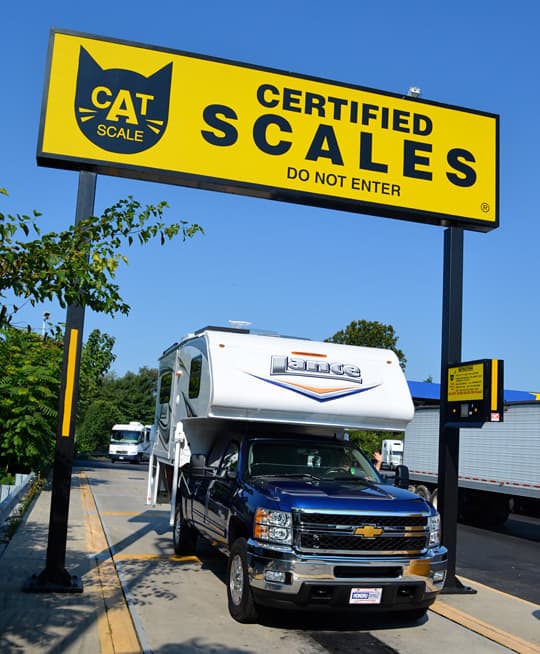
Above: 2013 Chevy Silverado 3500 and 2013 Lance 855S at a CAT scale
While we’re on the subject of dimensions, I want to echo the sentiments of Truck Camper Magazine and urge you to properly weigh your truck camper rig. As a professional truck driver with decades of experience, I recommend weighing your rig at a CAT Scale.
Link to the CAT Scale Locator – http://catscale.com/cat-scale-locator
CAT is the largest truck scale franchise here in the United States. They provide you with not only your gross weight, but also the weight for each axle of your rig. The cost is $10, which is not bad considering the satisfying, “Now I know” feeling you get afterwards. Stop guessing and go weigh your truck camper rig. You will be glad you did.
Other Tips, Tricks, and Random Divorce Avoiding Strategies
1. Unless they’re in the driver’s seat, never allow anyone else to drive. Help is one thing, but back seat driving can be dangerous. It can result in making panic turns and panic stops, Plus, it could hurry your journey to divorce court. One driver at a time, please.
2. Due to a little thing called gravity, it will take more power to get up a mountain, and more braking power to get down that same hill. You will need to increase your following distance, slow down, and take your time.
3. The raw power, enhanced suspension, steering, braking systems, tires, and overall refinement of today’s trucks can lull us into a false sense of security. Don’t let this happen. Modern trucks are safer, but you cannot drive them like cars. When driving your truck, practice safe truck driving.
4. Listen to your truck. When operating correctly, you should hear the purr of a fine-tuned engine and maybe some singing form your tires. When the camper is loaded, you will hear wind turbulence from the front of the camper and the space above and behind the truck cab – especially at highway speeds. This is not what I call an intrusive noise and it won’t be long before you barely notice it.
You should not hear anything that clangs, bangs, swishes, booms, rattles, clicks, or jingles. Each rig will have its own personality, with its own noises. Get to know what your truck sounds like and investigate those warning sounds. You may save yourself an expensive repair, or prevent a more serious problem down the road.
5. Always have a spotter when you back up your rig. When in doubt, use the GOAL system (Get Out And Look). You want to make sure there are no tree limbs, rocks, children, or pets behind your vehicle. When in doubt, stop and get out.
Take It Slow
I recommend taking things slow in the beginning to build up your comfort level. Getting comfortable driving a loaded truck and camper takes time. You need to experience the higher center of gravity and learn how to properly use your mirrors for visibility. Driving a loaded truck and camper will be new at first, but soon it will feel very natural. Practice, practice, and practice some more.
